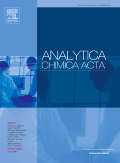
Analytica Chimica Acta
Scope & Guideline
Unveiling the future of analytical chemistry research.
Introduction
Aims and Scopes
- Analytical Method Development:
The journal emphasizes the creation and refinement of new analytical techniques, including chromatographic, spectrometric, and electrochemical methods, often aimed at improving sensitivity, selectivity, and efficiency. - Nanotechnology in Analysis:
There is a strong focus on the application of nanomaterials, such as quantum dots, metal-organic frameworks, and carbon nanomaterials, which enhance the performance of analytical methods and sensors. - Point-of-Care Testing and Field Applications:
Research often targets the development of portable and user-friendly diagnostic tools for on-site testing, particularly in clinical settings and environmental monitoring. - Bioanalytical Applications:
The journal frequently publishes studies related to the detection of biomolecules, including proteins, nucleic acids, and metabolites, with applications in disease diagnosis and monitoring. - Sustainability and Green Chemistry:
A noticeable trend is the development of eco-friendly extraction methods and materials, emphasizing the reduction of hazardous substances in analytical procedures. - Multimodal and Hybrid Techniques:
Research integrating multiple analytical techniques, such as combining chromatography with mass spectrometry or electrochemical detection, is prevalent, aiming for comprehensive analysis.
Trending and Emerging
- CRISPR-Based Detection Methods:
There is a growing trend in the use of CRISPR technology for sensitive and specific detection of nucleic acids and proteins, demonstrating the integration of molecular biology with analytical chemistry. - Smartphone-Assisted Analytical Techniques:
The development of portable, smartphone-integrated devices for real-time analysis and diagnostics is increasingly prominent, indicating a shift towards accessible technology in analytical applications. - SERS and Fluorescent Probes:
The use of surface-enhanced Raman scattering (SERS) and fluorescent probes for the detection of biomolecules and environmental contaminants has surged, showcasing advancements in sensitivity and specificity. - Microfluidics and Lab-on-a-Chip Technologies:
Research focusing on microfluidic devices for rapid and efficient analysis is on the rise, reflecting the demand for miniaturized, automated analytical systems. - Eco-Friendly Analytical Approaches:
The journal is increasingly publishing studies on green chemistry practices, including the use of biodegradable materials and sustainable extraction methods, highlighting the push for environmentally friendly practices in analytical chemistry. - Integrated Multi-Analytical Platforms:
There is a noticeable trend towards developing integrated platforms that combine various analytical techniques, allowing for comprehensive analysis and enhanced sensitivity.
Declining or Waning
- Traditional Spectroscopic Techniques:
While spectroscopic methods remain important, there has been a noticeable decline in publications focusing solely on conventional techniques without novel enhancements or integrations. - Basic Methodologies without Novelty:
Research that presents basic analytical methodologies without significant improvements or applications has become less frequent, as the journal increasingly favors innovative approaches. - Isolated Applications of Established Techniques:
There is a waning interest in studies that apply established techniques in isolation without integrating them into broader, more complex analytical frameworks. - Conventional Sample Preparation Techniques:
Traditional sample preparation methods are being overshadowed by more innovative, efficient, and eco-friendly alternatives, leading to a decline in their representation in recent publications.
Similar Journals

TALANTA
Shaping the Future of Analytical ChemistryTALANTA, published by Elsevier, is a premier international journal that serves as a vital platform in the field of analytical chemistry. Since its inception in 1958, TALANTA has provided a comprehensive forum for the dissemination of groundbreaking research and developments in chemical analysis, spanning a wide array of topics including biochemistry and spectroscopy. With an impressive impact factor and ranking in the Q1 quartile within its category for 2023, it is ranked #12 out of 156 journals in Analytical Chemistry by Scopus, placing it among the most influential journals in its field. Researchers, professionals, and students benefit from its stringent peer-review process and high-quality content that drives advancements in analytical methodologies and applications. TALANTA's commitment to fostering innovation and excellence in research makes it an indispensable resource for anyone at the forefront of scientific inquiry.

CRITICAL REVIEWS IN ANALYTICAL CHEMISTRY
Transforming Discoveries into Comprehensive Reviews.Critical Reviews in Analytical Chemistry, published by Taylor & Francis Inc, stands as a pivotal journal in the field of analytical chemistry, contributing significantly to its advancement since its inception in 1989. With an impressive Q1 ranking in the 2023 analytical chemistry category, it positions itself among the top 15 journals in the field, reflecting its high impact and relevance, as evidenced by a 90th percentile Scopus rank. This esteemed journal is dedicated to publishing comprehensive reviews that synthesize current research and emerging methods in analytical techniques, making it an invaluable resource for researchers, professionals, and students alike. With the goal of fostering innovation and collaboration, Critical Reviews in Analytical Chemistry continues to address challenges and breakthroughs within the sphere of analytical methodologies, ensuring its authors and readers remain at the forefront of scientific discovery.
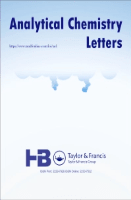
Analytical Chemistry Letters
Unveiling the Future of Analytical TechniquesAnalytical Chemistry Letters is a notable journal published by Taylor & Francis Ltd, focusing on the interdisciplinary aspects of analytical chemistry and its applications across various fields, including materials science and forensic medicine. With an ISSN of 2229-7928 and an E-ISSN of 2230-7532, this journal provides researchers and professionals a platform to share their findings from 2011 to 2024, fostering advancements in methodologies and technologies. Despite being classified in the Q3 and Q4 category quartiles across multiple disciplines, the journal is crucial for emerging studies and discussions, particularly in the context of innovative analytical techniques and their relevance to real-world challenges. While currently not an open-access journal, its rigorous peer-review process ensures high-quality contributions that are essential for academics, professionals, and students keen on bridging theory and practice. The journal continues to build its reputation, reflected in its Scopus rankings which place it amidst a competitive landscape, encouraging growth and collaboration within the scientific community.

Bulletin of the University of Karaganda-Chemistry
Pioneering Research in Chemistry and Related DisciplinesBulletin of the University of Karaganda-Chemistry is an esteemed academic journal published by KARAGANDA STATE UNIVERSITY, focusing on the field of chemistry and related disciplines. With an ISSN of 2518-718X and an E-ISSN of 2663-4872, this journal aims to disseminate high-quality research articles, reviews, and scholarly discussions that contribute to the advancement of knowledge in chemistry. Although it has experienced a transition in its coverage from 2021 to 2022, the journal remains a significant platform for researchers and students alike, promoting open access to its valuable content. Despite its current Scopus rank of #379/407 in the general chemistry category, the Bulletin of the University of Karaganda-Chemistry serves as a vital resource for the academic community in Kazakhstan and beyond, fostering collaboration and innovation in various chemical research domains. Researchers, professionals, and students are encouraged to engage with the journal as it continues to evolve and contribute to significant scientific discussions.

ANALYTICAL AND BIOANALYTICAL CHEMISTRY
Advancing the Frontiers of Chemical AnalysisANALYTICAL AND BIOANALYTICAL CHEMISTRY, published by SPRINGER HEIDELBERG, is a leading international journal that serves as a vital platform for innovative research in the fields of analytical and bioanalytical chemistry. With an impressive impact factor and ranking in the Q2 category for both Analytical Chemistry and Biochemistry, the journal highlights key advancements and methodologies that drive the discipline forward. Established in 1996 and continuing vigorously into 2024, it has gained significant recognition with Scopus rankings placing it in the 83rd and 78th percentiles within its categories, underscoring its impact and relevance. The journal's commitment to open access facilitates widespread dissemination of critical scientific knowledge, making it an essential resource for researchers, professionals, and students dedicated to exploring the complexities of chemical analysis. With its base in Heidelberg, Germany, ANALYTICAL AND BIOANALYTICAL CHEMISTRY continues to inspire and influence the global research community.
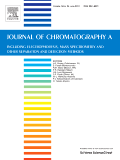
JOURNAL OF CHROMATOGRAPHY A
Transforming Chromatography Through CollaborationJOURNAL OF CHROMATOGRAPHY A, published by Elsevier, is a leading journal in the disciplines of Analytical Chemistry, Biochemistry, and Organic Chemistry, boasting an impressive 2023 Q2 categorization across multiple fields. With an ISSN of 0021-9673 and an E-ISSN of 1873-3778, this prestigious journal has been at the forefront of chromatography research since its inception in 1958. The journal serves as a vital platform for disseminating high-quality research articles, reviews, and insights into the latest developments in chromatographic techniques and applications, reflecting its standing in the top tier of analytical and organic chemistry literature, evidenced by its impressive Scopus rankings. While it currently operates under a subscription model, the journal continues to make significant contributions to the scientific community by fostering collaboration and innovation in chromatography methodologies. We invite researchers, professionals, and students to engage with the essential findings shared within its pages, which are foundational for advancements in various scientific fields, making it an indispensable resource for enhancing chromatographic knowledge and practice.

JOURNAL OF ANALYTICAL CHEMISTRY
Empowering Researchers in Analytical ExcellenceJOURNAL OF ANALYTICAL CHEMISTRY, published by PLEIADES PUBLISHING INC, stands as a pivotal resource in the field of analytical chemistry, offering an innovative platform for researchers, professionals, and students to advance their knowledge and contribute to the discourse within the discipline. With an ISSN of 1061-9348 and an E-ISSN of 1608-3199, this journal features a focused exploration of analytical methodologies, instrumentation developments, and applications across various domains, contributing to practical and theoretical advancements in the field. Currently ranked in the Q3 category in Analytical Chemistry with a Scopus rank of #111 out of 156, it provides critical insights and innovation strategies for professionals aiming to enhance their analytical capabilities. Access to the journal is through standard subscription models, and it covers an extensive range of topics pertinent to the discipline from 1996 to 2024. Engage with the JOURNAL OF ANALYTICAL CHEMISTRY to be part of a vibrant research community dedicated to push the boundaries of analytical practices.
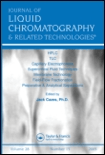
JOURNAL OF LIQUID CHROMATOGRAPHY & RELATED TECHNOLOGIES
Exploring Innovations in Liquid ChromatographyJOURNAL OF LIQUID CHROMATOGRAPHY & RELATED TECHNOLOGIES, published by Taylor & Francis Inc, is a pivotal platform for disseminating cutting-edge research in the field of liquid chromatography and its applications across various disciplines including analytical chemistry, biochemistry, and pharmaceutical science. With an ISSN of 1082-6076 and an E-ISSN of 1520-572X, this journal serves as an essential resource for researchers, professionals, and students committed to advancing the understanding and development of chromatographic techniques. Despite not being an open access publication, the journal features a robust submission process from 1996 to 2024, ensuring comprehensive coverage of historical and contemporary methodologies. Notably, it has achieved rankings in the Q3 and Q4 quartiles across various categories, reflecting its reputable position in the field. It’s recognized within key databases, with Scopus ranks indicating its influential role in areas such as pharmaceutical science and analytical chemistry. This journal is not only a cornerstone for specialized studies but also fosters interdisciplinary collaborations, making it an invaluable asset for the scientific community.

Brazilian Journal of Analytical Chemistry
Elevating Research Standards in Brazilian ChemistryBrazilian Journal of Analytical Chemistry, published by VISAO FOKKA COMMUNICATION AGENCY, serves as a vital platform for those engaged in the field of analytical chemistry, especially within the Latin American context. With an ISSN of 2179-3425 and an E-ISSN of 2179-3433, this journal aims to promote high-quality research and advancements in analytical methodologies, instrumentation, and applications spanning from 2010 to the present. Although it currently holds a Q4 rank in Analytical Chemistry by Scopus and is placed at the 24th percentile, its commitment to open access publishing provides invaluable opportunities for widespread dissemination of knowledge, catering to researchers, professionals, and students alike. The journal's editorial board comprises emerging and established experts aiming to bridge gaps in analytical chemistry research, particularly in a Brazilian and broader South American context. Situated in São Paulo, Brazil, the journal's role in fostering innovation and collaboration in analytical techniques makes it an essential resource for the academic community.
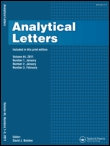
ANALYTICAL LETTERS
Innovating Laboratory Practices Through ResearchANALYTICAL LETTERS is a reputable journal published by Taylor & Francis Inc, focusing on the dynamic fields of analytical chemistry, biochemistry, and clinical biochemistry. With an ISSN of 0003-2719 and an E-ISSN of 1532-236X, the journal has been a platform for scholarly articles since its inception in 1967, and is set to continue its contribution to the scientific community until 2024. Despite its classification in Q3 across various categories as of 2023, including analytical chemistry and spectroscopy, ANALYTICAL LETTERS maintains a significant impact within its field, evidenced by its moderate rankings within Scopus. This journal serves as a vital resource for researchers and professionals seeking to explore recent advancements in analytical methodologies, instrumentation, and applications, facilitating the dissemination of critical insights in laboratory practices. With access primarily through institutional subscriptions, it remains positioned as a crucial tool for those advancing knowledge and innovation in analytical sciences.